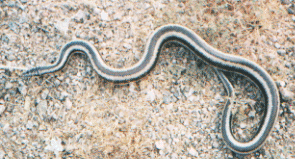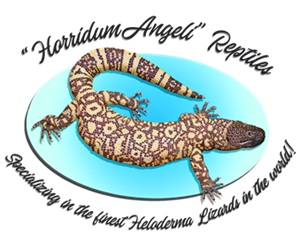 | mobile - desktop |
 |
Contact Sales! |
News & Events:
|
by Petra Spiess  Rosy boas are arguably one of the most popular Arizona natives in herpetoculture today.
Rosy boas are small, rarely exceeding 36 inches (90 cm), hardy, beautiful, and relatively
easy to breed. All of these traits combine to make the rosy boa a most attractive captive.
The ground color of rosy boas in Arizona ranges from a tan to a silver color. The dorsal
stripes range in color from a deep chocolate to orange. Some localities have extensive
amounts of speckling. Also, some localities have juveniles with chocolate stripes, while
adults in the same habitat have orange stripes. It appears as if rosy boas in this area
undergo an ontogenetic color change as they mature. Rosy boas range throughout the
southwestern half of the state, although isolated exceptions can be found (Stebbins,
1985). Rosy boa taxonomy is still being refined. In Arizona, many sources list two
subspecies of the rosy boa, Lichanura trivirgata trivirgata, the Mexican rosy boa,
which has a restricted range in extreme southwestern Arizona, and Lichanura trivirgata
gracia, the desert rosy boa, which is found across the rest of the range. In a
review of the genus done by David Spiteri (1993) however, Lichanura trivirgata gracia
is grouped with Lichanura trivirgata myriolepis, the mid-Baja rosy boa.
Spiteri also proposes that a new subspecies, Lichanura trivirgata arizonae, the
Arizona rosy boa, exits in western central Arizona. Taxonomists are still bickering about
this genus however, and whether or not these designations, or alternate groupings, will be
accepted as official has not yet been determined. Rosy boas are arguably one of the most popular Arizona natives in herpetoculture today.
Rosy boas are small, rarely exceeding 36 inches (90 cm), hardy, beautiful, and relatively
easy to breed. All of these traits combine to make the rosy boa a most attractive captive.
The ground color of rosy boas in Arizona ranges from a tan to a silver color. The dorsal
stripes range in color from a deep chocolate to orange. Some localities have extensive
amounts of speckling. Also, some localities have juveniles with chocolate stripes, while
adults in the same habitat have orange stripes. It appears as if rosy boas in this area
undergo an ontogenetic color change as they mature. Rosy boas range throughout the
southwestern half of the state, although isolated exceptions can be found (Stebbins,
1985). Rosy boa taxonomy is still being refined. In Arizona, many sources list two
subspecies of the rosy boa, Lichanura trivirgata trivirgata, the Mexican rosy boa,
which has a restricted range in extreme southwestern Arizona, and Lichanura trivirgata
gracia, the desert rosy boa, which is found across the rest of the range. In a
review of the genus done by David Spiteri (1993) however, Lichanura trivirgata gracia
is grouped with Lichanura trivirgata myriolepis, the mid-Baja rosy boa.
Spiteri also proposes that a new subspecies, Lichanura trivirgata arizonae, the
Arizona rosy boa, exits in western central Arizona. Taxonomists are still bickering about
this genus however, and whether or not these designations, or alternate groupings, will be
accepted as official has not yet been determined.
In Arizona, rosy boas often inhabit desert scrub containing prominent and abundant boulder piles which are utilized for hiding, aestivation, and hibernaculum. Rosy boas are also often found in rodent holes, which may serve both as a hiding areas, and as a source of sit-and-wait prey items. Although the macrohabitat of rosy boas is extremely low in relative humidity (average about 15-30%), the microhabitat is often two the three times more humid than the surrounding area. This pattern often occurs in the natural history of other desert reptile species such as the banded gecko (Coleonyx variegatus). Many people consider the rosy boa rare in Arizona, but it is likely that a relatively uniform dispersal rate and normal periods of extended inactivity are responsible for this assumption. Rosy boas spend a significant amount of time inactive in hiding areas, and venture out only when looking for a mate, food, or thermoregulating. Rosy boas have some interesting habits. Rosy boas I have observed in the daytime, or during a well-lit nighttime, move their bodies with a peculiar "jerking" motion of the head. As the snake progresses, the head continually moves forward and backward. This is possibly an attempt to break up the animal's body outline, as a large number of rosy boa predators are birds. Interestingly enough, I have not observed this behavior much in my captive born rosy boas. Rosy boas also have an interesting defensive mechanism. When molested, rosy boas will roll up in a ball with their heads in the center and their blunt tail sticking out. As a result of this behavior, many wild rosy boas are missing a significant portion of their tails, as predators attack the tail but do not succeed in capturing the entire animal. This is perhaps, one possible way to determine between a wild caught versus captive bred adult animal. Wild rosy boas are extremely docile and rarely bite. However, I personally have been bitten by more captive born rosy boas than by any number of other "more aggressive" snake species. Sufficed to say that in my experience, captive born rosy boas are best described as "feisty". The most rosy boa activity occurs in the spring and summer months. In the spring, rosy boas are mainly crepuscular, but as the temperatures rise into the summer months, they become almost exclusively nocturnal. Rosy boas have been observed moving across roads when the ambient temperature was as low as 68 degrees F (20 degrees C). The best time to find rosy boas is in the morning or evening hours of late spring when the relative humidity is moderate to high (50-80%). The ideal day for rosy boa activity would include a sunny morning, a brief afternoon shower to raise the humidity, and an overcast day and evening. If searching for rosy boas during the summer months, look only after the sun has gone down and there is little or no moonlight. Rosy boas seem to prefer nights with little or no moonlight, presumably because they are less visible and hence, less vulnerable to predation. Rosy boa captive care is straightforward. Rosy Boa Captive Care Wild caught rosy boas must be deparasitized, these animals can carry a heavy load of both internal and external parasites. The best procedure is to collect a stool sample after the animals has been set up in a quarantined enclosure and take it to a qualified reptile veterinarian to determine what parasites are present. Some people routinely deparasitize their animals without a preliminary fecal exam, but there is a danger with this type of treatment. Fecal exams have the express purpose of determining exactly which parasitic organisms are present in the animal, and as such, treatment can be specifically tailored to produce the best results. Deparasitation is also very stressful on an animal's physiology, and if that animal is not in the best of health before the treatment is enacted, it can exasperate an already dangerous situation. Unless the keeper is very experienced in determining what treatment should be given and when, it is recommended that a reptile veterinarian be consulted before any treatment is undertaken. Wild-caught rosy boas may have a difficult time acclimating to captivity, they may refuse to feed for months. Witwer (1996) suggests that providing a naturalistic environment may help wild rosy boas to acclimate. Captive born offspring are generally superior to wild-caught animals in all respects. Rosy boas are hardy captives if provided with the proper conditions. A thermal gradient of 70-75 degrees F (21-24 degrees C) on the cool end, to a warm spot of 85-88 degrees F (29-31 degrees C) on the warm end is ideal. Gravid females however, should have a warm spot of 88-92 degrees F (31-33.3) available during gestation. High humidity (in excess of 60%) for extended periods of time should be avoided. Natural history studies show that the microhabitat of rosy boas is much higher in relative humidity than the surrounding areas, so moderate levels of humidity should not be a major concern. Adult rosy boas can be housed in an enclosure that measures 3 x 2 x 2 ft. (1 x .66 x .66 ) (l x w x h). It is important to have an enclosure large enough so that the proper thermal gradient may be achieved. Substrates can include newspaper, paper towels, wood chips (not cedar), or substrate collected from rosy boa habitat. No matter which substrate is utilized, always provide rosy boas with a hiding area on both ends of the thermal gradient. The animal must be able to fit its entire body into the hiding spot. Rosy boas are naturally very secretive and will stress if not provided with a place to hide. Captive born rosy boas are generally very good rodent feeders, however, wild-caughts may have some difficulty adjusting to a diet of domestic mice. Breeding The rosy boa is a relatively easy snake to breed. Male rosy boas possess "spurs" on each side of the vent. Females of this species either do not have spurs, or they are very small. The only way to be 100% sure of sex is to probe. Male rosy boas probe to a depth of 10 or more subcaudals, and female can probe 3-5 subcaudals. Generally, rosy boas are sexually mature at 3 years of age. This species should be hibernated at 55-60 degrees F (12.7-15.5 degrees C) for two to three months. After the hibernation period, warm the animals up and feed them heavily (especially the females). Two weeks after coming out of hibernation, introduce the males to the females. Many breeders choose the leave the male with the female for a period of several weeks. Gestation takes anywhere from 3 1/2 to 6 months. The female will usually have a pre-parturition shed a week or two before birth. Rosy boas, like all boas, give birth to full-formed young instead of laying eggs. Litters range from 2-15 young. Rosy boas will only produce one litter of offspring in a breeding season. House the neonates individually, and provide the same conditions as are provided for the adults (with the exception of a smaller enclosure). Some individuals may be difficult to feed, and may need to be hibernated throughout the winter to stimulate their appetite. The vast majority of rosy boa hatchlings will eventually accept a domestic pinky mouse as their first meal, the ones who do not may be tempted by a lizard or wild-mouse scented pinky. Rosy boas are far more common in herpetoculture than the next Arizona native, the western green ratsnake. < Introduction - Back || Next - Green Ratsnake > |
Sponsored Link
Recent Rosy Boas Forum Posts • Rosy Diarrhea? Help appreciated, posted by Alora_Danon • I have a question, posted by eddie_the_yeti • trivirgata, posted by Mojave_Torts • Test, posted by Osira • Neonates and water, posted by nella1987sb • Rosys boa sex, posted by snakeboy40 • Regurgitating & Setup - My Experience, posted by Ameron • rosy regurging, posted by janome • My rosy wont eat., posted by KsNeff1 • Dome Rock, posted by markg • Some Bahia Magdalena rosies, posted by markg • Sexing Research - Many Mislead by Myths, posted by Ameron • rosy bite!, posted by SanDiegoBRB • color change, posted by neiltrais • rosy project advise?, posted by geckoejon • NEW ROSY MORPH !, posted by albinorosy • to dust or not to dust?, posted by mustacheman5 • Hypo Morongo Rosies, posted by Tony D • albino whitewater rosy boa, posted by zamatattoo • Rosy habitat, So Cal near the low desert, posted by markg Recent Rosy, Sand & Rubber Boa Classifieds: - WANTED Sand Boasall spec... - Albino Kenyan Sand Boawe... New & Updated Business Listings |





.jpg)

